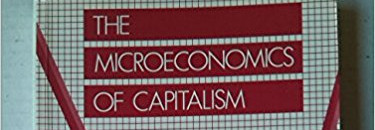
John Broome's "The Microeconomics of Capitalism"
Gregor Semieniuk
Recently, Prof. John Broome, has kindly put his textbook 'The Microeconomics of Capitalism' (1983) online for free use, after getting back the copyright from the publisher. Difficult to obtain as a hardcopy nowadays, this free online book is a valuable addition to teaching material for microeconomics.
The lucidly written textbook is couched around the analysis of theoretical economies with constant returns to scale, with the unit of analysis the class, and cost-based relative price determination. It is closest to Sraffa's exposition (acknowledged p. 219), but borrows from and synthesizes a variety of other sources. The explanations are well developed verbally and rely only on algebra, simple matrix algebra and occasionally differential calculus. After a brief preface and introduction that set out the vision and modelling approach respectively, chapter 2 introduces the one sector corn model, chapter 3 expands to multiple sectors including a discussion of capital aggregation. Chapter 4 introduces multiple techniques of production. It usefully derives also neoclassical marginal product-based pricing from its analysis of techniques of production and switch points, which I find particularly helpful for recognizing the common conceptual foundations of different production theories. The chapter further demonstrates the re-switching and reverse capital-deepening issues of the Cambridge capital controversies. Chapter 5 introduces a land-type input, and chapter 6 discusses 'further developments', namely joint production and non-constant returns to scale from indivisibilities. In its intermediate yet sophisticated approach, the book contributes a carefully crafted resource for instructors and students to learn about cost-based microeconomic theories of prices, distribution and growth.
Broome states in his reader's guide (p. ix) that the book is designed for a second or third course in microeconomics. What students without prior exposure to Sraffian economics are likely to struggle with is the different approach - no demand curves, no 'marginal' products and, at first, the thinking in terms of a self-reproducing system with beginning and end of period transactions. The introduction of a neoclassical labour market with scarce labour in chapter 2 is confusing and one idea is instead to just set a conventional wage (which is also done in several of the books' exercises). Some care needs to be taken not to delve into every excursus upon first reading, in order to keep eyes set on the main argument. The reader's guide offers some help with that. The book can well be complemented with Kurz and Salvadori (1995). The latter is too encyclopedic to be read easily in a course, and here Broome's book can help give shortcuts. On the other hand, Broome lacks all historical context, and here the Kurz and Salvadori book is useful.

 Reteaching Economics
Reteaching Economics